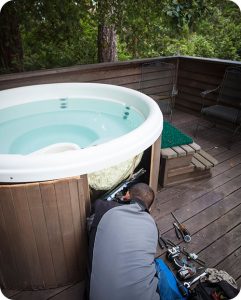Troubleshooting Hot Tub Temperature Fluctuations

Once you’ve entered the desired temperature on your hot tub’s control panel, you expect the heater to keep the water heated consistently. You don’t want it to get too hot, then cold, then get too hot again! Temperature fluctuations of more than a couple degrees are not normal, and often indicate a problem with water flow or a faulty switch.
For example, let’s say that you set the heating level to 103º, and the temperature falls below 100º before the heater kicks on. Once it does, the heater keeps going until the water reaches 105º or trips the high limit switch. Likewise, if you set the thermostat and find that your hot tub water is consistently hotter or cooler than expected, you may need to start troubleshooting common hot tub heater problems.
Verify the Water Temperature
First things first - make sure that your control panel is showing the correct water temperature. Stick a thermometer in the water to see if there’s a discrepancy in the temperature reading, which could indicate a faulty temperature sensor or thermostat. On most hot tubs, this sensor is located just inside of the filter housing. The temperature probe should be pushed down securely into the thermowell, and the capillary should not have any kinks. A faulty thermostat is one of the most common reasons for hot tub temperatures to bounce around.
Check Water Flow
Once that’s done, check that the filter is clean and not impeding water flow. Water levels in the hot tub should be high enough, and the pump impeller and lines should be free of obstructions and/or air to prevent flow problems. Make sure that the spa pump is working properly and there is adequate pressure coming out of the jets.
Test Switches, Sensors and Heating Element
Next, check your other switches and sensors. The high-limit switch can be found on the heater itself. The high-limit switch is a safety feature that prompts a heater to turn off when a certain maximum temperature is reached, and improper adjustment or failure can cause excessive temperature fluctuations, or the heater may not work at all. Likewise, a pressure switch or flow switch that is too sensitive or going bad can also cause a spa heater to malfunction. The thermostat, which we discussed in the first section, also impacts your hot tub's heating ability. Adjust as necessary in small increments, secure any loose connections, or replace the part if it’s no longer working. If the switches seem fine, check to make sure that the heater is still working and that the voltage reading across the leads of the heating element is correct.
Examine Other Factors
Other things to consider include the outside temperature, the insulating ability of your hot tub and hot tub cover, and whether the daily fluctuations in ambient outside temperatures are negatively impacting the water temperature inside your tub. If your hot tub frequently gets too hot in summer or consistently loses heat on cool evenings or during the winter months, insulation ability and/or the circulation schedule may be to blame. The inside of a spa cabinet can get warm very quickly, making it easy for water temps to fluctuate or overheat. Friction of the water circulating through the pump and plumbing lines also raises the temperature somewhat. An excessively warm spa cabinet may just need more ventilation, whereas a spa cabinet that’s too cool may need more insulation to help keep the heat from escaping. Use caution when adding insulation to the cabinet; placing it too close to equipment like the heater or spa pump can become a fire hazard. Hot tub covers should have the correct foam density for your climate and be well fitted to the hot tub. If your cover is sagging, heavy or starting to wear out, it may be time to buy a new hot tub cover.
Once you’ve found the source of your hot tub temperature troubles, you can work on fixing the problem at hand. Has troubleshooting indicated a faulty part? Check out the Top 5 Hot Tub Heater Problems for more info on diagnosing and repairing hot tub heater parts.